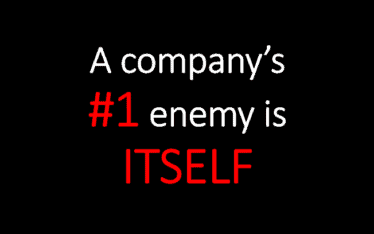Organizational change initiatives fail at an alarming rate
The digitization spiral is driving tremendous changes in the ways businesses and other organizations operate. Many traditional organizations are beginning to accept, in theory at least, that they must either change or die.
Strategically managing organizational change is critical to implementing new programs and initiatives, and ultimately, to achieving an organization’s success. Still, organizational change initiatives fail at an alarming rate. This is because most initiatives fail to consider how changes affect the people in an organization.
To successfully implement change initiatives, organizational leaders must identify the need for change and communicate it throughout the organization.
Engage people at all levels of the organization – Successful change management happens at the bottom
They must also engage people at all levels of the organization by involving them in the design of the implementation strategy.
Leaders must actively involve the people most affected by the change in its implementation. This will help ensure employees at all levels of the organization embrace the proposed changes.
Be wary of expressions like “mindset change” and “changing people’s mindsets”
Be wary of expressions like “mindset change”, and “changing people’s mindsets” or “changing attitudes”, because this language often indicates a tendency towards imposed or enforced change, and it implies strongly that the organization believes that its people currently have the “wrong” mindset, which is never, the case.
Successful change management – Don’t mandate change, ask staff for input
If people are not approaching their tasks or the organization effectively, then the organization has the wrong mindset, not the people.
Change such as new structures, policies, targets, acquisitions, disposals, etc., all create new systems and environments, which need to be explained to people as early as possible, so that people’s involvement in validating and refining the changes themselves can be obtained.
Whenever an organization imposes new things on people there will be difficulties. Participation, involvement and open, early, full communication are the important factors.
Tell a compelling change story
Management need to be able to tell a compelling change story that motivate employees. Before you you get buy-in, people need to feel the problem. People aren’t going to consider anything until they are convinced there is a problem that truly needs to be addressed.
Workshops are very useful processes to develop collective understanding, approaches, policies, methods, systems, ideas, etc. Storytelling can be a powerful tool when you want to drive organizational change.
Employee involvement is key in change management. Do it with them, not to them
Staff surveys are a helpful way to repair damage and mistrust among staff – provided you allow allow people to complete them anonymously, and provided you publish and act on the findings.
Management training, empathy and facilitative capability are priority areas – managers are crucial to the change process – they must enable and facilitate, not merely convey and implement policy from above, which does not work.
Don’t impose change
Don’t impose change – people and teams need to be empowered to find their own solutions and responses, with facilitation and support from managers, and tolerance and compassion from the leaders and executives.
Meaningful organizational change cannot occur without the cooperation of the affected stakeholders
Management and leadership style and behaviour are more important than clever process and policy. Employees need to be able to trust the organization.
Short URL & title:
Successful change management involves the employees — https://www.torbenrick.eu/t/r/xcr
Share it:
If you enjoyed this article, please take 5 seconds to share it on your social network. Thanks!









A good article that asks for a comment.
Personally I do believe that ‘changing the people mindsets’ is mandatory for sustaining Organizational Transformation. W. Edwards Deming wrote years ago “There is no change without Personal Transformation”. And each Personal Transformation starts with the change of the mindset. So people have to change their mindset, ALL people, not only those ‘at the bottom’.
You write it yourself: “The Organization has to change its mindset”. And what is an Organization more than a defined group of people. So they all have to change their mindset.
I believe we are at the evening of a new Paradigm. I call it the ‘Creative Interchange’ or ‘inside-out’ Paradigm. What practically will change in the new paradigm? Let’s start with change itself. Change projects will become transformation projects. Actually most change projects want to change what is and are constantly at war with the facts, while forcing people constantly into new models the ‘outside-in’ way. Transformation on the other hand is bringing out what is inside, thus the ‘inside-out’ way. During transformation you have to see the reality in a different way (i.e. a change in mindset). The sequence of transformation is ‘See-Feel-Do’.
As long as people don’t first see it and really feel it, no inside transformation is possible. At best, people will perhaps display another behavior, they’ll change their behavior temporarily and nothing will really be transformed, the mindset will not be altered.
If you really want transformation who is enduring, it has to come from the inside-out. This can IMHO only been done by living the Creative Interchange Process. This is the meta transformation process of life, which was for the first time described that way by dr. Henry Nelson Wieman, an American Religious Philosopher. Pay attention, Wieman did not invent the process, he just discovered it and gave it the name I use: Creative Interchange.
Creative interchange consist of four characteristics:
1. Authentic Interaction,
2. Appreciative Understanding
3. Creative Integrating
4. Continual Transforming
Deep transformation starts at the top (as your triangle picture suggests), not with the whole organization! What I see in the actual paradigm is thatthe change plan is first sold to management and then, immediately, rolled out in the Organization.
Deep transformation is accepting the need for personal transformation, starting with top management. They have to live the transformation process, thus the Creative Interchange Process by themselves – at least six months – before starting to roll it out in the Organization. And the rolling out should be a cascading down the Hierarchy
Followers do have Eagle eyes and SEE the difference between what Leaders say they will do and what they actually do, have accordingly FEELings and will take ACTION on those.
So what is needed, is that, before rolling out the transformation process, the members of the Management Team live the process themselves and do ask for and do give one another honest feedback about how they are living it. “Are we really doing ourselves what we will ask from our people in the near future?” is the crucial question.
Great article thanks. it is correct to say imposing change is not the route to go down but getting employees imput is the correct way to get it implemented effectively.
living in a culture of constant improvement might feel just a tiny bit less threatening than a culture of constant change. Fiddle with the word ‘improvement’, try willingness to … and/or a dozen more variants. I am totally on board with the concept of engaging the whole staff in accomplishing change. I also seek to engage the team in deciding what needs change etc. Once everyone becomes aware of what I have become aware of, change, and better changes than I had imagined, come to the table along with willing people to get started on those changes. A tricky topic and even though we see many articles every week about change, we have not solved it yet. Thanks Rick
Good article, I believe what you mean with organizational mindset is accumulative of mindset from people within the organization so basically it is people mindset, base on my experienced to be success change must starts from top to bottom. Thanks Rick.
While I agree with the premise of this article, it is absent of any strategies to involve employees. Mentioned are storytelling, staff surveys, and management training; none of those are involvement. The closest reference I see is “involving them in the design of the implementation strategy” which is involvement, but in my view the best opportunity is to involve them in actually implementing the change.